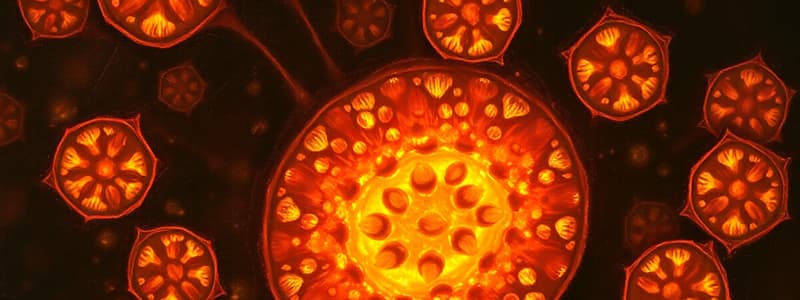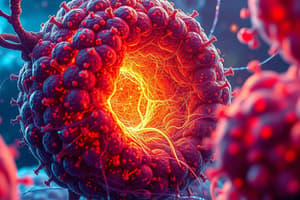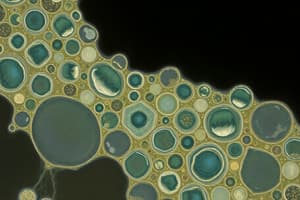Podcast
Questions and Answers
What characteristic distinguishes eukaryotic cells from prokaryotic cells?
What characteristic distinguishes eukaryotic cells from prokaryotic cells?
- Eukaryotic cells possess a membrane-bound nucleus, whereas prokaryotic cells do not. (correct)
- Prokaryotic cells have linear DNA, whereas eukaryotic cells have circular DNA.
- Eukaryotic cells contain ribosomes, while prokaryotic cells do not.
- Prokaryotic cells are generally larger and more complex than eukaryotic cells.
Which of the following is the most accurate description of cell theory?
Which of the following is the most accurate description of cell theory?
- All cells have a nucleus.
- Cells can spontaneously generate from non-living matter.
- All eukaryotic organisms are multicellular.
- All living things are composed of one or more cells, the cell is the basic unit of life, and all cells come from pre-existing cells. (correct)
Which cellular component is primarily responsible for synthesizing proteins?
Which cellular component is primarily responsible for synthesizing proteins?
- Mitochondria
- Endoplasmic reticulum
- Lysosomes
- Ribosomes (correct)
Which of the following bacterial processes involves the exchange of genetic material but is not considered asexual reproduction?
Which of the following bacterial processes involves the exchange of genetic material but is not considered asexual reproduction?
Which of the following environments are archaea known to inhabit?
Which of the following environments are archaea known to inhabit?
Which of the following is the PRIMARY function of bioremediation using prokaryotes?
Which of the following is the PRIMARY function of bioremediation using prokaryotes?
A scientist discovers a new unicellular organism. Upon examination, the organism is found to contain a peptidoglycan cell wall. To which domain does this organism most likely belong?
A scientist discovers a new unicellular organism. Upon examination, the organism is found to contain a peptidoglycan cell wall. To which domain does this organism most likely belong?
What is the primary role of the plasma membrane in eukaryotic cells?
What is the primary role of the plasma membrane in eukaryotic cells?
How do carrier proteins in the plasma membrane facilitate the transport of specific molecules across the membrane?
How do carrier proteins in the plasma membrane facilitate the transport of specific molecules across the membrane?
What role do enzymes in the cytoplasm perform in the cell metabolism?
What role do enzymes in the cytoplasm perform in the cell metabolism?
Which of the following is a function of the smooth endoplasmic reticulum (SER)?
Which of the following is a function of the smooth endoplasmic reticulum (SER)?
Which of the following explains the advantage of the folded inner membrane (cristae) of mitochondria?
Which of the following explains the advantage of the folded inner membrane (cristae) of mitochondria?
How do lysosomes contribute to the cell's functionality?
How do lysosomes contribute to the cell's functionality?
What is the significance of the Golgi Apparatus modifying, sorting, and packaging proteins and lipids?
What is the significance of the Golgi Apparatus modifying, sorting, and packaging proteins and lipids?
What is the primary role of vacuoles in plant cells?
What is the primary role of vacuoles in plant cells?
Which of the following is a key difference between plant and animal cells concerning energy-related organelles?
Which of the following is a key difference between plant and animal cells concerning energy-related organelles?
What role does the cell wall play in plant cells?
What role does the cell wall play in plant cells?
Which of the following distinguishes rough endoplasmic reticulum (RER) from smooth endoplasmic reticulum (SER)?
Which of the following distinguishes rough endoplasmic reticulum (RER) from smooth endoplasmic reticulum (SER)?
Which statement is most accurate when characterizing the structural composition of the plasma membrane?
Which statement is most accurate when characterizing the structural composition of the plasma membrane?
How does the semi-permeable nature of the plasma membrane contribute to cellular homeostasis?
How does the semi-permeable nature of the plasma membrane contribute to cellular homeostasis?
What is the structural relationship between the structure of the nucleus and its function?
What is the structural relationship between the structure of the nucleus and its function?
Which of the following best describes the role of cholesterol within the plasma membrane?
Which of the following best describes the role of cholesterol within the plasma membrane?
Which statement accurately contrasts the organization of genetic material in prokaryotic and eukaryotic cells?
Which statement accurately contrasts the organization of genetic material in prokaryotic and eukaryotic cells?
Which of the following correctly describes the function of the nucleolus?
Which of the following correctly describes the function of the nucleolus?
What is the crucial role of oxidation reactions carried out by peroxisomes?
What is the crucial role of oxidation reactions carried out by peroxisomes?
What process do contractile vacuoles use to expel water to regulate cell volume?
What process do contractile vacuoles use to expel water to regulate cell volume?
Which structural component is distinctly present in plant cells but not in animal cells, providing rigidity and shape?
Which structural component is distinctly present in plant cells but not in animal cells, providing rigidity and shape?
Within a eukaryotic cell, what is the consequence of a malfunction in the Golgi apparatus?
Within a eukaryotic cell, what is the consequence of a malfunction in the Golgi apparatus?
Unlike animal cells, plant cells contain chloroplasts. What function do chloroplasts perform?
Unlike animal cells, plant cells contain chloroplasts. What function do chloroplasts perform?
Enzymes are a type of what organic molecule?
Enzymes are a type of what organic molecule?
What is the function of nucleic acids?
What is the function of nucleic acids?
Which of the following organic molecules is known for being hydrophobic?
Which of the following organic molecules is known for being hydrophobic?
How do saturated and unsaturated fatty acids differ?
How do saturated and unsaturated fatty acids differ?
The hereditary material in cells is composed of what?
The hereditary material in cells is composed of what?
What role do carbohydrates have?
What role do carbohydrates have?
Which of the following best describes a protein?
Which of the following best describes a protein?
What are the finger-like projections some unicellular eukaryotes use?
What are the finger-like projections some unicellular eukaryotes use?
Which of the following is a critical characteristic that differentiates a prokaryotic cell from a eukaryotic cell?
Which of the following is a critical characteristic that differentiates a prokaryotic cell from a eukaryotic cell?
In the context of cell theory, what is the significance of the statement 'all cells come from pre-existing cells'?
In the context of cell theory, what is the significance of the statement 'all cells come from pre-existing cells'?
Which of the following factors would MOST LIKELY impair the function of ribosomes in both prokaryotic and eukaryotic cells?
Which of the following factors would MOST LIKELY impair the function of ribosomes in both prokaryotic and eukaryotic cells?
How does conjugation contribute to genetic variation in bacterial populations, and what is its significance in the context of antibiotic resistance?
How does conjugation contribute to genetic variation in bacterial populations, and what is its significance in the context of antibiotic resistance?
Given the extreme conditions in which certain archaea thrive, which adaptation would be MOST critical for their survival at high temperatures?
Given the extreme conditions in which certain archaea thrive, which adaptation would be MOST critical for their survival at high temperatures?
What is the PRIMARY ecological advantage of bioremediation using prokaryotes in the cleanup of oil spills?
What is the PRIMARY ecological advantage of bioremediation using prokaryotes in the cleanup of oil spills?
A newly identified unicellular organism contains both membrane-bound organelles and a peptidoglycan cell wall. Which taxonomic domain(s) could potentially include this organism?
A newly identified unicellular organism contains both membrane-bound organelles and a peptidoglycan cell wall. Which taxonomic domain(s) could potentially include this organism?
What specific modification to the phospholipid bilayer of the plasma membrane would MOST likely enhance the membrane's ability to maintain its fluidity at low temperatures?
What specific modification to the phospholipid bilayer of the plasma membrane would MOST likely enhance the membrane's ability to maintain its fluidity at low temperatures?
In what way does the enzymatic activity within the cytoplasm of a cell MOST contribute to metabolic efficiency?
In what way does the enzymatic activity within the cytoplasm of a cell MOST contribute to metabolic efficiency?
Which of the subsequent processes would be MOST affected by a significant reduction in the functional capacity of the smooth endoplasmic reticulum (SER) in a liver cell?
Which of the subsequent processes would be MOST affected by a significant reduction in the functional capacity of the smooth endoplasmic reticulum (SER) in a liver cell?
How does the presence of cristae, the folds of the inner mitochondrial membrane, enhance the organelle's ability to produce ATP through cellular respiration?
How does the presence of cristae, the folds of the inner mitochondrial membrane, enhance the organelle's ability to produce ATP through cellular respiration?
What is the PRIMARY advantage of lysosomes containing a diverse array of acid hydrolases within a eukaryotic cell?
What is the PRIMARY advantage of lysosomes containing a diverse array of acid hydrolases within a eukaryotic cell?
A researcher discovers that a line of cells is abnormally secreting proteins, with many proteins being released prematurely without proper folding or modification. Which specific organelle is MOST LIKELY malfunctioning?
A researcher discovers that a line of cells is abnormally secreting proteins, with many proteins being released prematurely without proper folding or modification. Which specific organelle is MOST LIKELY malfunctioning?
How does the central vacuole MOST contribute to the structural integrity and growth of plant cells?
How does the central vacuole MOST contribute to the structural integrity and growth of plant cells?
How does the presence of chloroplasts in plant cells MOST directly influence the roles of mitochondria, concerning energy production and metabolic function?
How does the presence of chloroplasts in plant cells MOST directly influence the roles of mitochondria, concerning energy production and metabolic function?
How does the cell wall in plants MOST effectively contribute to the plant's overall survival and adaptation in various terrestrial environments?
How does the cell wall in plants MOST effectively contribute to the plant's overall survival and adaptation in various terrestrial environments?
Which of the following structural differences between rough endoplasmic reticulum (RER) and smooth endoplasmic reticulum (SER) results in completely different functions within the cell?
Which of the following structural differences between rough endoplasmic reticulum (RER) and smooth endoplasmic reticulum (SER) results in completely different functions within the cell?
How does the selective permeability of the plasma membrane MOST contribute to cell survival in fluctuating environmental conditions?
How does the selective permeability of the plasma membrane MOST contribute to cell survival in fluctuating environmental conditions?
If peroxisomes were impaired, which of the following processes would be MOST significantly affected?
If peroxisomes were impaired, which of the following processes would be MOST significantly affected?
What is the immediate consequence if a plant cell fails to maintain a proper structure of thylakoids inside chloroplasts?
What is the immediate consequence if a plant cell fails to maintain a proper structure of thylakoids inside chloroplasts?
Flashcards
Cell
Cell
The smallest unit of a living thing that can carry on all life processes.
Cell Theory
Cell Theory
All living things are made of one or more cells, the cell is the basic unit of life, and all cells come from existing cells.
Cell/Plasma Membrane
Cell/Plasma Membrane
An outer covering that separates the cell's interior from its surrounding environment.
Cytoplasm
Cytoplasm
Signup and view all the flashcards
Hereditary Material (DNA)
Hereditary Material (DNA)
Signup and view all the flashcards
Ribosomes
Ribosomes
Signup and view all the flashcards
Prokaryotic Cells
Prokaryotic Cells
Signup and view all the flashcards
Binary Fission
Binary Fission
Signup and view all the flashcards
Conjugation
Conjugation
Signup and view all the flashcards
Eubacteria
Eubacteria
Signup and view all the flashcards
Archaea
Archaea
Signup and view all the flashcards
Bioremediation
Bioremediation
Signup and view all the flashcards
Eukaryotic Cells
Eukaryotic Cells
Signup and view all the flashcards
Flagella
Flagella
Signup and view all the flashcards
Pseudopod
Pseudopod
Signup and view all the flashcards
Cilia
Cilia
Signup and view all the flashcards
Organic Molecules
Organic Molecules
Signup and view all the flashcards
Proteins
Proteins
Signup and view all the flashcards
Enzymes
Enzymes
Signup and view all the flashcards
Structural Proteins
Structural Proteins
Signup and view all the flashcards
Motility Proteins
Motility Proteins
Signup and view all the flashcards
Regulatory Proteins
Regulatory Proteins
Signup and view all the flashcards
Storage proteins
Storage proteins
Signup and view all the flashcards
Hormonal Proteins
Hormonal Proteins
Signup and view all the flashcards
Receptor Proteins
Receptor Proteins
Signup and view all the flashcards
Transport Proteins
Transport Proteins
Signup and view all the flashcards
Special Purpose Proteins
Special Purpose Proteins
Signup and view all the flashcards
Lipids
Lipids
Signup and view all the flashcards
Nucleic Acids
Nucleic Acids
Signup and view all the flashcards
Carbohydrates
Carbohydrates
Signup and view all the flashcards
Plasma membrane
Plasma membrane
Signup and view all the flashcards
Cytoplasm
Cytoplasm
Signup and view all the flashcards
Nucleus
Nucleus
Signup and view all the flashcards
Mitochondria
Mitochondria
Signup and view all the flashcards
Peroxisomes
Peroxisomes
Signup and view all the flashcards
Lysosomes
Lysosomes
Signup and view all the flashcards
Vacuoles and Vesicles
Vacuoles and Vesicles
Signup and view all the flashcards
Endoplasmic Reticulum
Endoplasmic Reticulum
Signup and view all the flashcards
Golgi apparatus
Golgi apparatus
Signup and view all the flashcards
Cell Wall
Cell Wall
Signup and view all the flashcards
Chloroplast
Chloroplast
Signup and view all the flashcards
Large Central Vacuole
Large Central Vacuole
Signup and view all the flashcards
Study Notes
Introduction to Cells
- Cells will be studied from BIO 101 lectures 4 and 5.
- Supplementary reading is recommended for more detailed explanations.
- The link is https://rwu.pressbooks.pub/bio103/chapter/introduction-to-cells/
Cell Overview
- Although nasal sinus cells, onion cells, and Vibrio tasmaniensis bacterial cells are from vastly different organisms, they share certain characteristics of basic cell structure.
- A cell represents the smallest unit of a living thing, capable of independently performing all life processes.
Microscopy
- Light microscopes and electron microscopes are used for visualizing cells.
- Salmonella enteritidis bacteria can be viewed using light, transmission electron, and scanning electron microscopes.
History of Cells
- In 1665, Robert Hooke discovered cells while observing cork cells.
The Cell Theory
- All living things consist of one or more cells.
- The cell constitutes the basic unit of life in all organisms.
- All cells originate from pre-existing cells.
Classifications of Cells
- Eukaryotic Cells include Plants, Animals, Fungi, & Protists/Protoctists
- Prokaryotic Cells include Bacteria and Archaea.
Similarities Between Cells
- Every cell has a cell/plasma membrane -- an outer boundary separating the interior from the environment.
- Every cell has cytoplasm -- jelly-like cytosol with cellular components.
- Every cell has hereditary material (DNA).
- Every cell has ribosomes.
- Ribosomes synthesize proteins inside a cell.
Prokaryotic Cells
- Consist of bacteria.
- Lack a nucleus.
- Have long, circular DNA.
- Do not have membrane-bound organelles.
- Contain ribosomes for making proteins.
- Most possess a peptidoglycan cell wall.
- They are rod-shaped, spherical, or spiral.
- Prokaryotes typically reproduce asexually.
- Binary fission happens when an organism duplicates its DNA and divides into two, each getting one copy of DNA.
- Conjugation is the exchange of DNA between bacteria (not asexual).
- Prokaryotes can be classified as eubacteria or archaea.
- Eubacteria are commonly found.
- Archaea are live in extreme environments, such as hot springs, salt lakes, and submarine volcanic habitats.
- Halophiles, methanogens, and thermoacidophiles are specific for archaea
Applications of Prokaryotic Cells
- Bioremediation uses prokaryotes added to water to convert toxic pollutants into harmless substances.
- Food production relies on Butter, Cheese, Yogurt, Sauerkraut, Beer, Pickles, Olives, Chocolate, Coffee, Soy sauce, meats, etc.
- Importance for decomposition.
- Aids in digestion.
- Helps in nitrogen fixation for plants.
- Prokaryotes can cause food spoilage and disease in plants/animals and produces toxins.
Eukaryotic Cells
- Are more complex and larger than prokaryotes.
- Have membrane-bound organelles.
- Possess a nucleus.
- Contain more DNA than prokaryotes.
- Have linear DNA.
- Examples: animals, plants, and fungus. Movement in unicellular eukaryotes involves several mechanisms.
- Flagella are tail-like projections.
- Pseudopods are referred to false-feet.
- Cilia are finger-like projections (some non-motile).
- Eukaryotic cells have a plasma membrane, cytoplasm, and organelles.
- Organelles: nucleus, ribosomes, mitochondria, peroxisomes, vacuoles, and vesicles.
Organic Molecules
- Key organic molecules are carbohydrates, nucleic acids, proteins, and lipids.
Proteins
- Represent very diverse and complex macromolecules.
- Play roles in structure, function, and information.
- Proteins consist of linearly arranged amino acid residues.
- Primary Protein Structure is the amino acid sequence
- Secondary Protein Structure is the helix
- Tertiary Structure is polypeptide chains
- Quaternary Structure is aggregation of two or more polypeptides
Protein Types and Function
- Enzymes catalyze covalent bond breakage or formation, such as amylase.
- Structural proteins include collagen, elastin, and keratin.
- Motility proteins are actin, myosin, and tubulin.
- Regulatory proteins bind to DNA to switch genes on or off.
- Storage proteins include ovalbumin and casein.
- Hormonal proteins are insulin and nerve growth factor (NGF).
- Receptors are hormone and neurotransmitter receptors.
- Transport proteins carry small molecules or irons.
- Special purpose proteins are green fluorescent protein.
- Proteins sources include both Plants such as Soya Beans, Lentils etc and animal products such as eggs.
Lipids
- Are hydrophobic molecules used for: energy storage, membrane components, and signaling.
- Types: triglycerides (fat), phospholipids, waxes, and sterols.
Types of lipids
- The main lipids are Triglycerides, Phospholipids, Steroids and Waxes
- Lipids can both Saturated and Unsaturated
Carbohydrates
- Includes sugars, storage (glycogen, starch), and structural polymers (cellulose and chitin).
- Major substrates of energy metabolism.
Nucleic Acids
- DNA (deoxyribonucleic acid) encodes genetic information.
- RNA encodes genetic information for protein synthesis.
- They are building blocks of life.
Eukaryotic Cell - Plasma Membrane
- Components: Phospholipids, Cholesterol, Integral protein, Glycolipid, Peripheral protein, and Glycoprotein
- Characterized by hydrophobic/hydrophilic components and a fluid-like phospholipid bilayer.
- Allows selective isolation of cell contents.
- It regulates substance exchange with (organic molecules, ions, water, oxygen, CO2 etc) and communicates.
Eukaryotic Cells - Cytoplasm
- Consists of the space between the plasma membrane and the nuclear envelope.
- Made of organelles suspended in gel-like cytosol, cytoskeleton, and various chemicals.
- The cytoplasm is about 70% to 80% water.
- The sits for metabolic reactions
Eukaryotic Cells - Nucleus
- Properties: Nuclear membrane, chromosomes, nucleolus, and ribosomes.
- Functions: Houses DNA and directs ribosomes.
- Mitochondria are oval-shaped, double-membrane organelles, and contain their own ribosomes and DNA. These are responsible for making ATP
- Peroxisomes are small, spherical organelles enclosed by single membranes.
Lysosomoes
- Are small, spherical compartments that function as the digestive and organelle-recycling facility of animal cells.
- Hydrolytic enzymes with an pH of 4.5 break down non-functioning organelles and pathogens,
Vacuoles and Vesicles
- Are membrane-bound sacs that function in storage and transport.
- Vacuoles store food and may expel water
Endoplasmic Reticulum
- Are a series of interconnected membranous sacs for protein (RER) and lipid(SER) synthesis.
- The Golgi Apparatus proteins and lipids bud to be packaged/ sent like "the poster office " of the cell
Plant vs Animal Cells
- Plant cells have a cell wall (cellulose), chloroplasts, and a large central vacuole.
- The cell wall in plant cells is external to the plasma membrane and the rigid covering that protects the structure and gives shape
Chloroplasts
- Plant cells organelles that carry out Photosynthesis to makes glucose and oxygen
Lysosomes
- Animal cells (not plants) have lysomomes for garbage/ recycle disposal
Studying That Suits You
Use AI to generate personalized quizzes and flashcards to suit your learning preferences.



